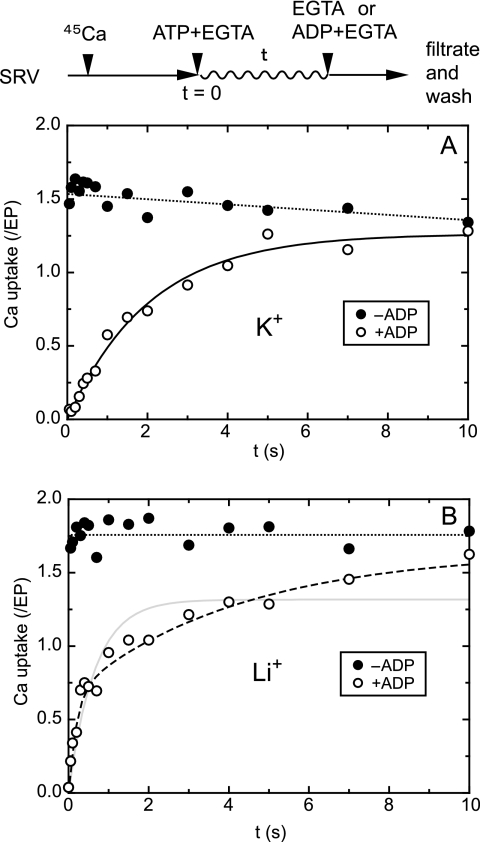FIGURE 4.
45Ca2+ uptake in a single turnover of EP with and without K+. All of the solutions contained 0.1 m KCl (A) or LiCl (B). In the absence of the Ca2+ ionophore, SR vesicles (SRV; 20 μg/ml) were first incubated with 10 μm 45CaCl2 for ∼10 min, and then Ca2+ uptake in a single turnover of EP was initiated by mixing with an equal volume of a solution containing 20 μm ATP and 2 mm EGTA, as described in Fig. 3. After the indicated periods, the reaction was chased with an equal volume of a solution containing 2 mm EGTA without (closed circles) or with (open circles) 2 mm ADP. The mixture was immediately spotted on the membrane and washed for ∼10 s with 1 ml of a 2 mm EGTA solution. The amount of 45Ca2+ on the membrane, i.e. transported into the vesicles and/or remained bound to the ATPase and not released to cytoplasmic side, was normalized to the maximum total amount of EP formed immediately after the addition ATP and EGTA (Fig. 3). In A, the time course obtained with the ADP chase was best described by a single exponential Ca2+ uptake (solid line) with a rate constant of 0.49 s−1 and maximum Ca2+/EP value of 1.26. In B, it was best described by a double exponential (broken line) with a rate constant and maximum Ca2+/EP value of 5.1 s−1 and 0.66 for the fast phase and 0.24 s−1 and 0.98 for the slow phase (but it was not described by a single exponential increase shown by solid line with the rate constant of 1.54 s−1 and maximum value of 1.31). Note also that without the ADP addition, almost of all the bound Ca2+ ions are transported into the vesicles during the ∼10-s EGTA wash because the single turnover of EP is nearly completed in this period (see Fig. 3).

